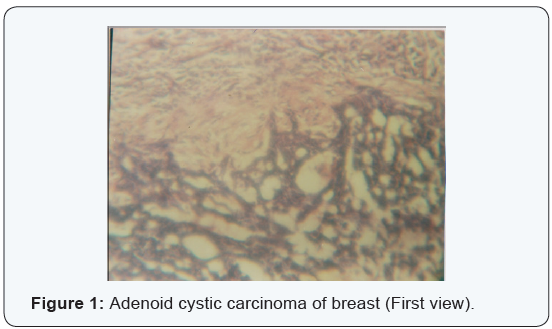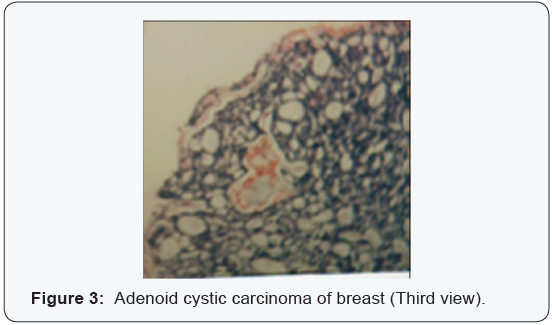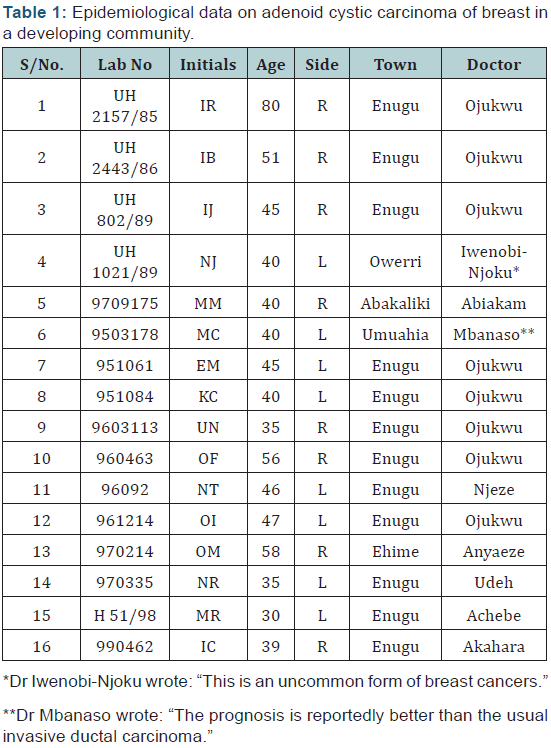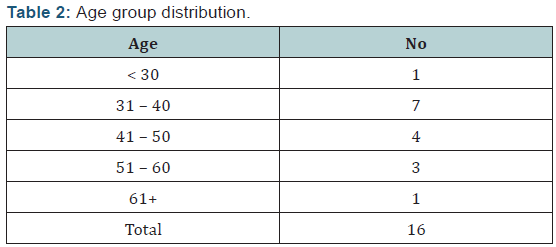Juniper
Publishers-Open Access Journal of Case Studies
Epidemiology of Adenoid Cystic Carcinoma of the Breast in a Developing Community
Authored by Wilson IB Onuigbo
Abstract
A well recognized rare breast entity is the adenoid cystic carcinoma [ACC]. Indeed, a few series have long been reported from several parts of the world. Now, according to the Birmingham [UK] group, there is the concept that the histopathology data pool promotes epidemiological analysis. Therefore, the purpose of this paper is to present from a developing community the data collected from such a pool with reference to women of the Ethnic Group called the Ibos or Igbos, who live mainly in the South-eastern region of Nigeria. Of the sixteen collected examples, most were gathered from the Cosmopolitan City of Enugu. Both sides were affected equally. The 31-50 age groups preponderated, while a particular surgeon dominated the operation scenery. Distant practitioners profit by sending biopsies to a centrally located Reference Laboratory.
Keywords: Breast; Type; Carcinoma; Adenoid cystic; Distance; Ibos; Enugu; Niger
Introduction
During the 1970s, there was a rise in the reprint request [RR] traffic. Thus, I freely received during that time single or few case reports as reprints on ACC at my request [1-5]. Incidentally, the microphotographs were compelling, although there were some variations. By 1980, Macartney, Rollaston and Codling [6] postulated from Birmingham (UK) that the establishment of a histopathology data pool would facilitate epidemiological analysis. Fortunately, this idea was in consonance with my own work in those days.
Investigation
During the 1980s and 1990s, the author was privileged to head a Reference Pathology Laboratory situated in Enugu, the capital city of the then Eastern Region of Nigeria. Its histopathology data pool yielded 506 breast carcinomas, 16 being diagnosed personally as ACC. They are analyzed hereunder. Illustrative photographs are also adjoined (Figure 1-3).



Results
Tables 1 and 2 show the epidemiological analyses. It is evident


- that the lesions featured equally on both sides,
- most specimens were from the cosmopolitan city of Enugu,
- there was preponderance in the 31-50 age groups and
- Surgeon Ojukwu took pride of place.
Discussion
Among the RRs of the 1970s, let me select, on purpose, the careful work of Anthony and James [5]. They presented 3 cases from 2686 breast cancers within a period of 10 years. Moreover, as they agreed, “The term adenoid cystic carcinoma is the one recommended by the World Health Organization in preference to other synonyms.” Their range of photographs confirmed the requisite appearances. Also noteworthy was its tendency to carry a uniquely favorable prognosis when compared with similar tumors elsewhere in the body.
In the local context, ACC was diagnosed in a 68-year-old surgeon well over a decade ago as regards his bowel cancer; it has till now proved truly prognostic [7]. Also, I have found it to be a molecular variant in local albino skin cancers [8]; their own follow up should also be fruitful.
Concerning the recent world literature, what are some pointers? From India, a 40-year-old female with final histopathologic diagnosis of ACC underwent adjuvant external beam radiotherapy and was on follow-up without recurrence for more than a year [9]. From Seoul, Korea [10], the report on 6 patients was to the effect that “Although some of our patients developed local recurrence or distant metastases, all patients had favorable clinical course, and to date, none of the patients has died from complications of her disease.” Concerning a joint Korea-USA study [11], their comprehensive review provided experience with the ACC of the breast as well as an overview of clinical, histopathological, and molecular genetics, features. From the Mayo Clinic in USA [12], the conclusion was clear, namely, “Recognition of ACC is important to avoid delay in diagnosis because this tumor has a good prognosis with rare metastases to axillary lymph nodes. Axillary nodal sampling by fine-needle aspiration or core biopsy is rarely indicated.”
A population-based cohort study of ACC in the United States (1977 to 2006) was conclusive [13]: Breast-ACC among women is characterized by ER-negative/PR-negative expression, rare regional lymph node involvement, a favorable prognosis with excellent survival, and absence of associated cancers. These findings reinforce the importance of tailored treatments for breast-ACC and lend credence to the apparent heterogeneity of basal-like breast cancers. Incidentally, there was debate in the UK as regards the benefit accruable to practitioners distant from a Reference Laboratory [14]. Indeed, the experience in this developing community is that of its desirability [15].
For
more Open Access Journals in Juniper Publishers please
click on: https://juniperpublishers.com/journals.php
For
more articles in Open Access
Journal of Case Studies please click on: https://juniperpublishers.com/jojcs/
To
know more about Peer
Review Journal of Case Studies



No comments:
Post a Comment